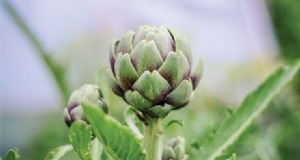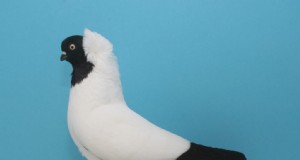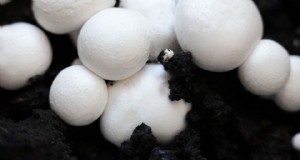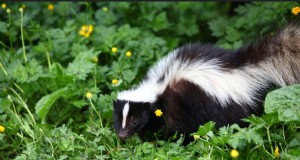A i r – B reathing f är h c slut re
Murreller och kattfiskar är kända för sin aktning och goda efterfrågan på marknaden på grund av sin låga fetthalt och få intramuskulära ryggar. De luftandande fiskarna är tåliga och kan andas atmosfärisk luft med sina accessoriska andningsorgan. På grund av närvaron av dessa tillbehör andningsorgan kan dessa fiskar överleva i några timmar utanför vattnet. Dessa accessoriska andningsorgan är andningsträd i Clarias , labyrintorgan i Channa , luftblåsa in Heteropneustes , grenkammare i ovanstående fiskar, etc. och kan suga upp luft. Dessa kan odlas i områden med lågt löst syre såsom grunt smutsigt vatten, övergivna dammar och träsk. På grund av deras förmåga att leva utan vatten, deras kultur innebär låg risk och enkel hantering.
I Indien, Andhra Pradesh, Assam, Uttar Pradesh, Madhya Pradesh, Tamilnadu, Karnataka, Maharastra, Bihar och Meghalaya stödjer det mest betydande naturliga fisket av luftandande fiskar. Dessa fiskar är köttätande till sin natur och de anpassar sig utmärkt till kompletterande utfodring. Eftersom det inte finns mycket slöseri med energi genom andning av de växande luftinblåsningarna i grunda vatten, goda skördar kunde förväntas.
De odlingsbara arterna av luftandande fiskar är Fig. 9.1
C h a nn a s t r a den u s – Stor eller randig murrel eller ormhuvudfisk
C hann a punctatu s – Fläckig murrel
Channa marulius – Jättemurrel
Clarias batrachus – Magur
Heteropneustes fossilis – Singhi
Anabas testudineus – Koi eller klätterabborre.
Av dessa Channa striatus har störst efterfrågan på marknaderna och har också ett högre pris. Näst bäst är Clarias och Heteropneustes . Kulturen av ovanstående arter är lönsam.
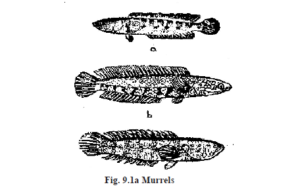
a) Channa marulius b) Channa straitus c) Channa punctatus
Cu l turab l e område s
Kulturen av luftandande fiskar behöver grunda vatten med ett djup på 50 – 75 cm. Dammar för luftandande fiskodling behöver inte gödslas med kemikalier. Luftandande fiskar kan också odlas i burar i rinnande vattensystem som bäckar, kanaler och ohanterliga vatten som reservoarer. Fiskkulturen som andas luft är lika anpassningsbar i vatten som är olämpliga för konventionella odlingsbara arter av karpar såväl som i karpodlingsdammar. Grunda dammar är användbara för fiskar, där fisken måste spendera mindre energi på att resa till ytan för intag av atmosfäriskt syre.
Ser d collectio n
Murrelfröet, magur och singhi samlas in från naturresurserna, trots framgång som uppnåtts i inducerad avel. Även i dag, frön som samlats in från naturen fortsätter att vara den mest pålitliga källan till material för lagerhållning. Murrels når mognad på två år är kända för att häcka under hela året. Ynglen på 2-4 cm kan samlas in året runt och från regnmatade diken och grunda vattendrag med rikligt med ogräs. Det är dock känt att topplek inträffar strax före monsunerna.
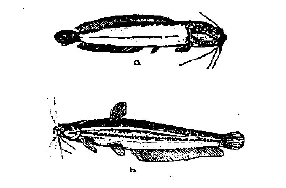
a) Clarias batrachus b) Heteropneustes fossilis
Ungarna som kommer ur äggen rör sig i stim och det är alltid lätt att samla in dem i stort antal. Fingerungarna tenderar kanske inte att röra sig i stim. Yngel av jättemördare kan identifieras på deras mörkgrå kropp och ett lateralt orangegult band från ögat till stjärtfenan. Yngel av avskalad murrel har klarröd kropp med rödaktigt gyllene band och ett mörksvart band från ögat till stjärtfenan. Den prickiga murrelyngeln kan kännas igen på deras mörkbruna kropp med ett gyllengult lateralt band och en mitten av ryggen gul linje på ryggen.
I murrelkulturen, det är bättre att lagra fingerlingar i stället för yngel. Kannibalism återfinns hos murryngel. Överlevnaden för yngel som produceras genom inducerad avel kommer att vara dålig och det är svårt att upprätthålla leken och växa fram till yngelstadiet. Leken äter ingenting på två dagar efter att de kommit upp från ägg. Därav, ynglen bör tränas att ta emot kompletterande föda i separata dammar. Tillskottsfodret består av kokta ägg, silkesmask puppor, malet skräp och maskar tillsammans med jäst och vitamin B.
Det ges i cirka 15 dagar i en hastighet av 20 % av deras totala kroppsvikt. Ynglen når fingersättningsstadiet på 4-6 cm längd inom en månad.
Kattfiskarna häckar två gånger om året med hög häckningssäsong under regnperioden. Magurfingrar kan identifieras med sin längre ryggfena och skifferfärg. Singhi fingerlingar har en kort ryggfena och rosa färg. Koi-fingerlingar kan identifieras av den mörka fläcken på stjärtspindeln och grönaktig nyans på den dorsala ytan av kroppen. Magurerna gör ett hål på 25 cm djup i bunten under vattenytan. De befruktade äggen fäster vid gräs och vaktas av hanarna. 2, 000 – 15, 000 yngel kan samlas upp från varje hål med hjälp av små finmaskiga handnät och födas upp i plantskolor tills de når fingersättningsstadiet med ca 5 cm längd.
Magur kan odlas i dammar för produktion av yngel. 1 X 1 m fack av trådskärm är gjorda på kanten av bunten. I mitten av varje fack, ett hål på 30 cm diameter grävs och är försett med få vattenväxter. Efter att ha släppt båda könen, ca 5, 000 yngel kan hämtas från varje fack inom 10 dagar. Hanarna och honorna kan också födas upp i små jorddammar. De kan lagras 20, 000 / damm och matas antingen med filtrerat djurplankton eller hackat fiskmjöl och jordnötsoljekaka. Ynglen kan födas upp i 15 dagar i plantskolor.
Högsäsongen för insamling av fröer av singhi är förvinterperioden när paddy skördas och de lågt liggande fälten exponeras.
Ser d tr a nspor t
Ynglen eller fingerungarna från fiskar som andas luft kan transporteras utan syreförpackning. Trummor av polyeten eller järnfat används för transport av yngel eller fiskar. Bäraren måste ha tillräckligt med utrymme för att deras vanliga yta ska kunna andas atmosfärisk luft. Bäraren bör ha en liten mängd vattenlevande ogräs som Vallisneria, Hydrilla , Myriophyllum och Ceratophyllum . Ogräset kan hjälpa till att undvika att fisken hoppar av under transporten. Om avståndet är längre, det är bättre att transportera dem i syreförpackade polyetenbehållare.
Pon d ma n ageme n t
Plantskolor är ca 10 – 15 m2, med en vattenpelare på 50 cm. Dessa lagras med 0,2 – 1,5 miljoner yngel/ha. Innan strumpan, gödsling sker med enbart rå boskapsdynga i en mängd av 500 kg/ha. Tvål-olja-emulsionen för att utrota insekter appliceras på barnkammarens vatten. Yngel och fingerlingar av magur och singhi som samlats in från naturresurser kräver förvaltning av plantskolor, men murreller måste tränas i barndammar innan utsättning. Efter skötseln av plantskolorna ska fiskarna flyttas till utsättningsdammar.
Stoc k i g
Fingerungar av enhetlig storlek väljs för strumpa. Fingerungarna desinficeras med 2 % KMNO4-lösning i 5 minuter eller doppas i 200 ppm formalinlösning i 50 sekunder innan lagring. Sårade fingerlingar behandlas med 0,3 % akriflavin i 5 minuter.
Dessa fiskar kan fly genom klättring eller grävning. Därav, dammarna ska vara fasta med tung stock eller trä, eller inhägnad med bambu käpp eller tråd skärmar till en höjd av ca 50 cm.
Fler fingerungar kan lagras i deras odlingssystem. 40, 000-60, 000 system.
fingerlingar/ha av kattfiskar kan lagras i monokultur I polykultursystem 20, 000 – 30, 000 fingerungar/ha katt
fiskar får utsättas. I monokultursystem, 15, 000 fingerungar/ha jättemördar, 20, 000/ha vid randig murrel och 20, 000 – 30, 000 / ha vid fläckig murrelare lager. I polykultursystem, randig och prickig murrel kan lagras med en hastighet av 20, 000 fingerungar / ha i förhållandet 1:1.
Polyodling av murreller – karp och havskatt – karp är också möjlig med rätt skötsel och skötsel. Fröet av luftandande fisk bör lagras först när karparna har vuxit till minst 300 gr. så att fiskar som andas i luften inte kan förgripa sig på karparna. Med detta, inte bara en extra inkomst kan erhållas genom avkastningen av luftandande fisk, men även karparnas tillväxt kan förbättras. Det senare är möjligt, som skräpfiskar som kan konkurrera med karpar om mat och utrymme, utrotas av de växande luftventilerna.
Mata in g
För att upprätthålla en riklig mattillgång för växande luftventiler, utsättningsdammen måste vara rik på animaliska livsmedel såsom grodyngel och skräpfiskar. Om denna födokälla inte är tillräcklig kan tilapia också odlas i dammar och fiskdammar. Torkad marin skräpfisk används också i fiskodling och är mer ekonomisk. Utfodring kan ges till malar med fiskbiprodukter eller slakteriavfall eller torkade silkesmaskspuppor blandade med riskli och oljekaka i förhållandet 1 :1 :1 :1. En blandning av oljekaka, riskli och biogasslurry i förhållandet 1 :1 :1 har gett framgångsrikt lågkostnadsfoder för singi. Riskli och fjäderfäfoder i 3 :1 och biogasslurry och risklid i 1 :2 ges också i en mängd av 5 – 8 % av kroppsvikten.
Under åtta månaders semi-intensiv odling i stillastående dammar, luft-andande havskatt kan utfodras i följande takt dagligen under dygnets mörka timmar för att få bättre foderutnyttjande (tabell 9.1).
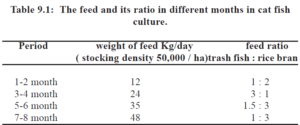
Fodret kan antingen sändas ut i dammen i små mängder från bunten eller kan serveras i foderkorgar som är sänkta nära stranden förutom att sända foder för att säkerställa tillgången på foder till alla fiskar i dammen. Ljusfällor kan installeras i valldammar, genom vilken insekterna kan attraheras av ljus och utnyttjas av murreller som en proteinrik föda.
Utbildade mördarvingar kommer också att acceptera billigt torkade marina skräpfiskar indränkta i vatten, som kan tillhandahållas enligt följande utfodringsschema (tabell 9.2). Slakthusavfall och silkesmaskpuppor som animaliskt proteinkälla kan också användas.
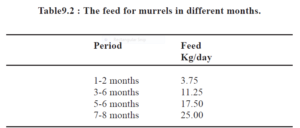
Gr o vikt h a n d sid r od u ct i o n
Murrels och kattfiskar når säljbar storlek inom en period av respektive månader. Om förvaltningspraxis är korrekt, gigantiska och randiga murreller kan uppnå en tillväxt på 1 – 2 kg/år. och 0,75 kg/år. respektive, medan fläckiga murreller växer till 160 gr. på 8 månader. Kattfiskar är kända för att växa långsamt jämfört med mördar. Magur och singhi växer till 0,2 kg respektive 0,1 kg. Omvandlingsfrekvensen med rekommenderat foder är ungefär 2:1.
Murreller med foderfisk som tillskottsföda ger ca 4 ton/ha/år. Magur med torkad skräpfisk och risklidtillskottsfoder, ge en produktion på 10 ton/ha/år. Singhi ger en avkastning på 4,4 /ton/ha/år. Polykultur av murrel och koi, matad med riskli, senapad oljekaka och skräpfisk, ge en produktion på 11,8 ton/ha/år, medan magsur och singhi utfodrade med riskli och skräpfisk ger en avkastning på 5 ton/ha/år. Blandad kultur av 3 arter av mördar producerar 4 ton/ha/år när de matas med blötlagda och torkade marina skräpfiskar och färska silkesmaskpuppor som föda. I den intensiva odlingen kan magur ge 7 ton/ha/5 månader.
C ul t ur e w i t h ca r sid s
Med en beläggningstäthet på 5000/ha indiska och kinesiska karpar och 1000 magurfingerungar producerar 2518 kg/ha/år karp och 3711 kg/ha/år magur. Detta indikerar att polykulturen är mer lönsam, och det är användbart att inkludera magur i karpodlingssystemet. Med en beläggningsdensitet på 20, 000/ha magur tillsammans med överbliven karp (efter partiell skörd av karp) produktion på 3,96 ton/ha/år erhålls med ett förhållande på 50 :30 :17 :3 riskkli, fisk måltid, jordnötsoljekaka och mineraler som tillskottsfoder. Maguren har funnits lämplig för sammansatt fiskodling av karpar i stället för vanlig karp. Magur, koi och singhi är också lämpliga att odla tillsammans med en högt prissatt karpmakhana, Euryale ferox .
Har v estin g
Sommarsäsongen är idealisk för att skörda luft - andas fiskar från dammar. Dammen dräneras och fiskarna skördas med hjälp av skopnät eller handnät. På grund av deras höga efterfrågan och marknadspris, kulturen av dessa luft – andningshål ger lönsamma inkomster till fiskodlare med enkla förvaltningstekniker.
C a g e kult u r e
Luftluften kan också odlas i burar. Burarna är förberedda med mattor av kluven bambu i rinnande vatten. Den optimala burytan mäter 2m X 1m X 1m i storlek. Den övre delen av buren är halvtäckt med matta och den otäckta delen är täckt med ett nät för att underlätta utfodring och för att förhindra att fiskar rymmer. Syntetfibernät används också för att förbereda burar.
Magur lagerförs med en hastighet av 200/bur, utfodras med 10 % av kroppsvikten på torkad skräpfisk, oljekaka och riskli och ger 10 – 12 Kg/cu.m./år. Singhi producerar 12-20 kg/cu.m./år med en beläggningstäthet på 100 – 150/bur och 10 % av kroppsvikten foder av silkesmaskspuppor, riskli och senapsoljekaka. Koi producerar 4,2 kg/cu.m./år med en beläggningsgrad på 50 – 100/bur med samma mat som singhi. Fläckig murrel producerar 4 kg/kubikmeter/år med skräpfisk och riskli. Därav, fiskkulturen som andas luft är mycket lönsam, samt en rik källa till animaliskt protein. Denna fisk anses vara en delikatess, och kräver ett mycket högt pris och en kontinuerlig efterfrågan på marknaderna.
T R OU T CU L T UR E
Öring odlas antingen som matfisk eller sportfisk, släpps ut i naturliga vatten för sportfiskare. Öring är populär eftersom den är en attraktiv, aktiv kampfisk och ger kött av mycket hög kvalitet. Öringar har satts ut och odlats i vatten över hela världen. Öringar har odlats i kommersiell skala i USA sedan mycket lång tid. Dess kultur i Europa går tillbaka 400 år. Det är en kallvattensfisk. Den bebor huvudsakligen floder, strömmar, bäckar, sjöar och dammar. I Indien finns det i Kashmir, Himachal Pradesh, Uttar Pradesh, Nilgiris, Kodai hills och Munnar high range.
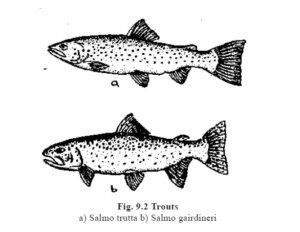
Många öringarter odlas, men de tre vanligaste av dem är regnbåge, Slamo gairdneri eller Oncorynchus min kyss, den euroreanska öringen, S.trutta (Fig. 9.2)och bäcköringen, Salvelinus fontinalis. Öringar har en strömlinjeformad kropp, smala gälöppningar och reducerade gälar. Öring är anpassad till mycket syresatta vatten och fryspunktstemperaturer. Öringar har stor rörelseförmåga med kläng- och grävvanor. Munnen är modifierad med raspande läppar för matinsamling från småsten, stenar, etc..
S sid aw n i g
Lekperioden för S.gairdneri är från september till februari, S.trutta är från oktober till december och S.fontinalis är från oktober till januari. Öringar föredrar grusigt underlag för att skydda sina ägg och äggen fastnar på grus och skräp. Öring bygger bon och leker i bäckar. Kulturister tillåter konstgjord befruktning, eftersom strömbäddsgödsling ger mindre kläckningshastighet än konstgödsling. Manipulering av fotoperioden och vattentemperaturen kan användas för att inducera gonadial mognad, så att unga fiskar genereras under hela året. Öringar fångas vid eller nära mognad när de simmar uppströms och föds upp till mogna dammar. Yngelfiskarna placeras i små dammar med rinnande vatten och är ofta täckta med nät för att hindra dem från att hoppa. Milten från en enda hane kan användas för att befrukta två honor, så att fler honor odlas med få hanar.
Öringar uppvisar sexuell dimorfism. Hanarna blir mer färgglada och underkäken utvecklar en kroknäbb under häckningssäsongen. Honor utvecklar förlängda magar och könspapillen blir större och rödaktig. När de är helt mogna, mjölk eller ägg kommer ut med lite tryck på bukhålet. När öringen är mogen, fiskhonorna avskalas och äggen samlas i en svartfärgad emalj- eller plastbehållare till vilken hanens milt tillsätts och blandas noggrant med en fjäderpenna för befruktning. Vatten tillsätts efter blandning och vattnet får äggen att svälla. Vatten ska inte tillsättas före blandningen, eftersom rörligheten hos spermierna minskar kraftigt i närvaro av vatten. För att säkerställa en bättre överlevnadsgrad, äggen kan samlas i en liten mängd saltlösning (10 liter färskvatten +90 gr. koksalt + 2 gr. kaliumklorid + 3 gr. kalciumklorid). De befruktade äggen utvecklar en grön nyans och är kända som "gröna", som sedan överförs till kläckerier. Ta bort främmande partiklar och döda ägg innan överföringen.
T ra ns sid o r t på i o n o f t vild flykt e gg s
De befruktade och stelnade äggen (härdade i 24 timmar) av öring transporteras i kartonger av 20 X 30 X 20 cm storlek. Kartongens insida är fodrad med frigolitfoder. Två fuktiga svampar eller bomullsdynor är arrangerade, en på undersidan och en annan på ovansidan. Porösa polyetenpåsar innehållande ca 4, 000 ägg läggs mellan de fuktiga svamparna och bomullsrondellerna. En polyetenpåse med IKg bruten is förvaras för att hålla låg temperatur, ovanför den övre dynan. Dessa kartonger transporteras till olika platser.
Hatcher y tec h nique s
Öringäggen inkuberas genom att de förvaras i betongtråg med platta och horisontellt anordnade brickor, inkubatorer eller burk. Kläckerier bör förses med cirkulerande filtrerat och siltfritt sötvatten. Förr i tiden användes korgar för inkubation. Vertikalflödesinkubatorer är de vanligaste. Den har många rostfria stål, av glasfiber, aluminium, eller trä, eller PVC, eller plastbrickor, anordnade ovanför varandra. Botten av brickorna är försedda med perforerade zinkplåtar, glasgaller eller nätduk för att säkerställa passage av vatten genom de olika brickorna. Storleken kan variera från 180 X 30 X 10 cm till 500 X 100 X 50 cm. Varje bricka har en övre äggkorg och ett nedre perforerat fack som korgen vilar på. Äggen läggs i korgen för ruvning. Vattnet förs in i brickan på ett sådant sätt att det rinner upp genom korgen som innehåller äggen, sedan ner till brickan nedanför och upp genom den korgen och så vidare genom inkubatorn. Detta uppåtgående flöde av vatten genom äggen möjliggör ökad luftning och underlättar avlägsnande av metaboliter.
Kläckningsburkar används också för ruvning av öringägg. Den består av en galvaniserad skärm av 0,5 mm maskvidd med grusbädd i botten, precis ovanför inloppet. Denna grusbädd är användbar som filter för att ta bort oönskade partiklar. Äggen placeras ovanför filtret för kläckning. Vatten passerade genom inloppet, stiger upp genom filtret och äggen och rinner ut genom utloppet. Efter kläckning, kläckningarna hålls kvar en tid i burkarna.
Äggen är mycket känsliga under kläckningsperioden. Nybefruktade ägg kan dödas om de utsätts direkt för solljus. Under inkubationen, vatten måste röra sig och ha hög syrehalt. Inkubation sker normalt i vatten med 8° -12°c temperatur. Ynglen kan hållas i brickorna tills de blir aktiva och kan börja mata. De kan släppas ut för utsättning i naturliga vatten.
Cu l tu re o f t rou t s
Ynglen föds upp i små uppfödningstråg innan de helt har absorberat sin gulesäck, och introducera att leva på konstgjorda foder. Sedan överförs de till plantskolor för uppfödning till avancerad yngelstadium. Barnkammarens damm kan vara betong- eller stenmurade med storleken 2,5 X 1 X 0,75 m till 9 X 1 X 0,75 m. Vattenflödet kan hållas 100 lit/min. inne i barnkammarens dammen.
De avancerade ynglen föds upp till vuxna i uppfödningsdamm och löpbanor. Uppfödningsdamm är en naturlig vattenmassa, och en raceway är bara en fiskdamm med rinnande vatten. Storleken på löpbanorna bör variera från 20 -100 m2 med ett djup på 1,5 m. En serie löpbanor är konstruerade på vardera sidan av bäcken eller floden. Varje löpbana får vatten från bäcken och vatten går ut ur löpbanan genom utloppet som finns på motsatt sida. Zinkplåtskärmar används vid inlopp och utlopp. Vattenflödet hålls 50 lit/sek, in i dammarna från floden. Cirkulära och ovala dammar används i USA. Beläggningsgraden kan begränsas till att producera 5-10 kg/m2. Hög produktion på 200 kg/mis även möjlig i racerbanor, om förvaltningen är bra.
Burodling av öring är också vanlig. I ett experiment, fingerlingar lagrades med 1,4 kg/m2 i burar och matades med 3 % av sin kroppsvikt dagligen. Dessa öringar växte till 27-88 gr. om två månader. Fodret som ges till öring inkluderar boskapsmjälte, hjärta och lungor och havs- eller sötvattensopor. Många kommersiella öringfoder finns tillgängliga på marknaden. Öring utfodras 3 – 4 gånger dagligen. Det finns många sätt att ge foder till öringar. Fodret sprutas antingen på vattenytan, eller fodret kan förvaras i en påse eller i en behållare i hörnet av dammen. Den används för efterfrågematare, där närhelst en öring stöter på avtryckaren släpps fodret ut i vattnet, eller automatiska matare kan också användas. Burkar och fat används också för uppfödning av öringyngel.
Se w ag e – Fe d F i s h Cu l tu re
Avloppsvatten är en grumlig, smutsig och luktande vätska från våra toaletter och kök i våra hus. Den har mineraler och organiska näringsämnen i löst tillstånd eller dispergerat i fast tillstånd. Bortskaffande av avloppsvatten har blivit ett globalt problem på grund av urbaniseringen. Det är en effekt av demofora, dvs. en oförminskad tillväxt av mänsklig befolkning. På senare år har avloppsvatten har blivit en stor förorening i inre vatten, särskilt floder. Det är en källa till många epidemier. Den är ansvarig för ett allvarligt hot mot mark- och vattenekosystemen. Tillvägagångssättet för bortskaffande av avloppsvatten bör vara utnyttjande av denna restprodukt med tanken att de återanvänds eller återvinns genom ett ekologiskt balanserat system som huvudsakligen involverar vattenbruk. Användbarheten av avloppsvatten för att förbättra bördigheten i sötvattendammar har länge varit känd i många länder i världen.
Mängden avloppsvatten som produceras är Indien i 3,6 mm3/d (miljoner kubikmeter per dag) eller 800 mg/d (miljoner gallon per dag). Cirka 30 % (1,9 mm3/d) produceras i tätorter. Endast 1,3 mm3/d (20,4 % av Indiens totala endagssumma) behandlas vid dessa centra. Nästan 80 % av landets totala endagssumma återstår fortfarande att behandla och utnyttja. Mängden gödsel som erhålls från endagsproduktion av avloppsvatten i Indien är cirka 0,126 m.ton. Detta motsvarar 46 m.ton/år. Gödseln från endagsavloppsvatten räcker för att odla 0,1 m.hektar årlig fiskskörd. Avloppsvatten är också användbart för att odla fiskar. I Indien finns endast 130 plus avloppsmatade fiskodlingar som täcker en yta på 12, 000 hektar. Vidyadhari avloppsmatade fisket nära Calcutta är ett exempel, där fiskare har utnyttjat avloppssystemen i Calcutta fullt ut. Här är fiskutbytet ca 1, 258 kg/ha. Den höga gödselkapaciteten kombineras med möjligheten att fungera som en ytterligare vattenkälla för fiskodling och förbättra fiskproduktionen.
Co m posi t io n o f sewa g e
Avloppsvattnets sammansättning varierar från plats till plats och beroende på säsong. Vatten är en viktig komponent i avloppsvatten (99 %) och den fasta suspensionen i avloppsvatten uppgår till endast 1 %. On an average the sewage of Indian towns contains 52 ppm nitrogen, 16 ppm phosphorus, 45 ppm potassium and 350 ppm biodegradable organic matter. The organic carbon component is 25-40 ppm, the ratio of carbon and nitrogen being 1:3. Salts of several heavy metals such as Zn, Ni, Cr, Pb, etc. are also found above the permissible levels in sewage. The organic refuses in the sewage have proteins, carbohydrates and fats in varied proportions depending on the nutritional status and food habits of the population. Among carbohydrates, readily degradable starch, sugar and cellulose are detected.
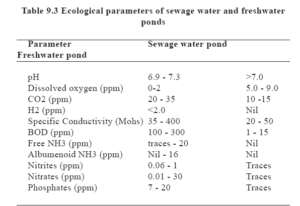
Some ecological features of different waters are mentioned in Table 9.3. Sewage water has high BOD (Biological Oxygen Demand) and Oxygen Consumption (OC) values. Dissolved oxygen becomes depleted in sewage water due to high oxygen demand and low photosynthetic rate. Photosynthesis is low because of poor illumination as the suspended solids in sewage water obstruct sunlight. I genomsnitt, strong, medium and weak sewage consist of 1200 ppm, 720 ppm and 350 ppm of total solids respectively, out of which 850 ppm, 500 ppm and 250 ppm occurs in a dissolved state and 350 ppm, 220 ppm and 100 ppm is found in suspended form. Dissolved salts being very high in sewage water, manifest high specific conductivity. Production of acids in high amounts render the water acidic, making the medium unfit for supporting life (Fig. 9.3). Acidity of water below pH4 is known to kill the flora and fauna.
Sewage enriches water with organic matter that begins to decompose aerobically thereby depleting dissolved oxygen and leading to anoxic condition. Anoxia causes non-mortality of animals, adding organic matter further to the already rich organic content. In the absence of dissolved oxygen the organic matter undergoes anaerobic decomposition as a result of which obnoxious gasses like H2S, CH3 and CO are produced. These gasses besides being toxic, react with water to form acids.
Immediate effect of sewage on the biota is eutrophication. Sewage water stimulates rapid growth of phytoplankton leading to an algal bloom followed by rapid increase in zooplankton. For utilizing sewage in aquaculture, the properties such as the concentration of dissolved and suspended solids, organiskt kol, nitrogen and BOD are essential.
Micro b iolog i ca l c harac t arist i c s
Harmless and even useful non-pathogenic bacteria are present in much greater numbers in domestic sewage as compared to pathogenic bacteria comprising mostly the intestinal microorganisms found in the community producing the waste. Usual load of coliform bacteria in raw sewage ranges between 108 and 109 MPN/100ml.
Si t e s e lect i o n a n d c onst r ucti o n o f se w age- f e d fis h långt m
Fish farm in the vicinity of an urbanized area has the scope to receive domestic sewage for the recycling of nutrients. Any area adjacent to a municipal sewage treatment plant is ideal for the location of a sewage-fed fish farm. The fish farm site should be at a lower level than the treatment plant so that the sewage can easily enter into the pond through a pipeline by gravity. The fish farm should have facilities of draining out water from the ponds.
The plan of the fish farm depends upon the source of the sewage, system of culture and topography of the land. Nearly 75% of the total area is converted into ponds leaving the rest for dykes and other purposes. Rectangular fish ponds of 0.3 to 1 ha are constructed with a slope of 1:3 for the embankment and maximum depth of 1.5m. Each pond should have proper drainage facilities.
The effluent is collected in a sump at the farm, from where the effluent is taken into the ponds through the distributing system. Additional arrangement is made to connect the pipelines with freshwater supply for emergency dilution.
S e vifta e tr e atme n t
Sewage treatment is necessary to kill the harmful microbes, prevent anoxia, raise the pH to an alkaline level, increase photosynthesis, reduce organic content, etc. The treatment has to be inexpensive and one which induces in sewage water the conditions prevailing in a natural freshwater pond. Sewage is treated in following three ways – mechanical treatment, chemical treatment and biological treatment.
Mech a nica l t reatment:
Solids and organic matter are removed to a large extent by mechanical treatment, which involves flowing, dilution and sedimentation. Usually screening and straining of sewage it is done to remove the waste solids. The liquid and semisolid wastes are then
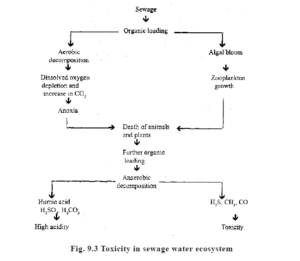
subjected to treatment for the removal of colloidal and semisolid suspension by dilution, H2S, CO2, CO, NH3, CH3 concentrations are brought below the normal levels. Således, through primary treatment the supernatent effluent is separated from the sludge.
C h emic a l t reatment:
In chemical treatment, several dissolved substances, harmful germs and aggressive odours are eliminated. Inexpensive precipitants,
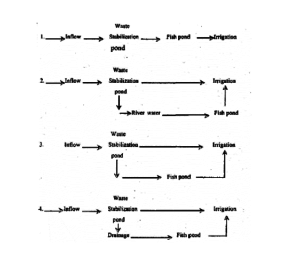
coagulants, chelating substances, disinfectants, deodorising agents, etc. are used in this treatment. The sewage water is also treated with chlorine, bleaching powder and copper sulphate. It is also known as secondary treatment.
Biol o gica l t r e atment :
In biological treatment of sewage care is taken to promote bacterial growth. Bacterial action promotes oxidation of organic matter. The end products nitrogen oxides, bring about rapid growth of algae, particularly the blue green Microcystis. This arrests anoxia of water by raising the dissolved oxygen, lowering the CO2 content and by increasing the pH from acidic to alkaline levels. The algal bloom reduces the concentration of dissolved salts in the sewage water.
Po n d Ma n ag e män t
F e rtil i zati o n
Fertilization of sewage-fed pond is done in two phases, pre-stocking and post-stocking fertilization. In dewatered and sun dried ponds, primary treated sewage effluent is taken up to a depth of 60 – 90 cm during premonsoon months (April – May). The effluent is then diluted with rain water or freshwater till the pond BOD reduces to 50 ppm. Periodic fertilization with sewage effluent is carried out after two months of stocking to maintain nutrient status and productivity of the pond at a desired level. The quantity of sewage effluent to be allowed into a pond solely depends on its quality determined on the basis of BOD values.
Limin g
Application of lime in sewage-fed ponds is most essential. It is a useful promotor of fertility in ponds and act as a disinfectant against harmful microorganisms. Prestocking liming is recommended at a rate of 200 – 400 Kg/ha as initial dosage. Subsequent liming of 150 – 200 Kg/ha on standing crop is necessary throughout the year during sewage intake and during winter months, when parasitic infection is more.
Stoc k i g
The cultivable species of freshwater fish such as Indian major carps and exotic carps can be grown in sewage-fed waters. Considering the high carrying capacity and high productivity of sewage-fed ponds with respect to plankton and benthic fish food concentration, fish are usually stocked at a reasonably higher density. The stocking rate recommended 10, 000 – 15, 000 /ha of carp fingerlings of about 10 gr. each and it is preferred to stock more of omnivorous scavengers and bottom feeders to maintain fish pond hygiene for higher yield. The ratio of carps for better output is rohu 2.5 :catla 1:mrigal 2.5 :common carp 2 :silver carp 2. Omnivores and bottom feeders directly consume the organic detritus of sewage-fed ponds, and thereby directly helping in keeping the pond aerobic. The stocking rate of fish is kept on a higher side considering the profuse growth of algae which will otherwise grow, decay, putrify and finally deplete the oxygen concentration of fish pond.
E c ologica l c onsideratio n s ett d a lga l forts r o l
Maintenance of aerobic conditions of the sewage-fed pond is highly essential and as such early morning dissolved oxygen level should not deplete below 2 ppm for carps. The BOD should be below 30 ppm for better survival of fishes. CO2 concentration should not be allowed to increase beyond 20 ppm to keep the toxicity level within tolerance limit for fish and to control algal blooms. Liming helps in regulating CO2. Heavy metal pollution, om någon, can be controlled by introducing water hyacinth at the pond margins and barricading them with bamboo poles to prevent spreading of the weed throughout the water surface of the pond.
Algal control is a must to maintain proper dissolved oxygen. It should be more than 2ppm and optimal 5 – 6 ppm in a sewage-fed pond. The presence of silver carp regulate the algae in the culture system. When biological control of algal bloom is not possible, application of simazin at rate of 0.5 – 1 ppm is recommended.
Con t ro l o f a q uat i c inse c t
Aquatic insects are found in sewage-fed ponds, especially more during winter months. The insects of the pond mainly comprises hemiptera, coleoptera, odonata, zygoptera and trichoptera. Dipteran insects dominate, especially the larval stages of Chironomids associated with annelid worms of tubificidae.
Other insect larvae of the sewage-fed ecosystem belong to tubanidae, anthomyiodae, tetanocoridae, etc. The predacious hemiptera, coleoptera and a few odonata, zygoptera are needed to be controlled. An emulsion of soap and vegetable oil at a rate of 4 Kg/ha and in the ratio of 1:3 is applied to control these insects.
H arvestin g ett d yi e l d
After 5 – 6 months culture, when the biomass grows to an optimal level, the stocking density is thinned out through periodical and partial harvesting. The water depth of the pond is reduced by dewatering for final harvest when the fishes are removed by repeated drag netting.
In a mixed culture of five carp species in sewage-fed ponds, the yield rate varies from 5.4 – 8.6 t/ha/yr with an average production of 7 tonnes/ha/yr. The fishes are around 500 gr. to 1000 gr. during culture operations.
The recurring expenditure on sewage-fed fish culture is meagre compared to that of fresh-water fish culture. This culture is lucrative and a fish farmer can obtain an income, on an average of more than Rs. 40, 000 /ha/yr. If murrels are cultured in oxidation ponds and the excess sewage is utilised for the cultivation of crops, the revenue could be further augmented.
Full utilization of sewage has manifold benefits. Outbreak of epidemics can be prevented. Biogas from sewage can be used as fuel to ease the pressure on LPG, electricity and fuel wood. Slurry from biogas plants can be used as a manure. Water reclaimed from sewage can be recycled for irrigation and pisciculture. Förutom, scientific handling of sewage generates employment opportunities to educate youths. More than all these water bodies, rivers, particularly can be saved from sewage pollution by proper management.
Utilisat i o n o f Bioga s Slurr y fo r fi s h cultu re
In our country, especially in rural areas, mere has been a tremendous growth of biogas plants as a source of non-conventional energy. Biogas is also called as gober gas. The biogas plant is a device for conversion of fermentable organic matter, especially cattle dung into combustible gas and fully matured organic manure or slurry by anaerobic fermentation. The nutrients of the generated slurry can be harvested for production of feed and food and replace conventional inorganic fertilizers. Due to lack of knowledge and communication to farmers, most of the generated slurry is not used properly. The biogas plant can also digest night soil, poultry and piggery droppings, weeds and other fermentable materials along with cattle dung. Biogas slurry consists of 1.52 mg/lit nitrogen, 0.82 mg/lit of phosphorus and 0.83 mg/lit of potash. Biogas slurry is rich in humus and contains nutrients mostly in the available form. The oxygen demand for its decomposition is much less than for raw cattle dung or any other organic manure. Due to the high nutrients value of biogas slurry, it can be used as a fertilizer in fish culture ponds. Slurry application improves the soil structure. It enhances zooplankton production in water.
Gober gas plant is a composite unit of a digester and gas holder. Gas holder floats on the top of digestor, wherein gas is collected. In the plant, the whole system is based on continuous operation. The organic manure to be fermented is fed in semi-fluid form at the one end and the fermented spent slurry is extracted at the other end periodically with disturbing the whole system. Slurry is odourless, free from flies and other sources of infection.
In a preliminary experiment, the slurry from plant is drained into a fish pond of 0.15 ha area, which is stocked withrohu, catla, mrigal, common carp, silver carp and grass carp at a density of 7, 500 fishes/ha, resulted in production of 5080 kg/ha/11 months (762 kg/ha/0.15 ha/ 11 months).
This experiment indicates that the high production potentiality of the pond using only biogas slurry as fertilizer. In Madurai Kamaraj University, the experiments conducted with Oreochromis mossambica by using only biogas slurry as fertilizer and found the enhanced production. They indicated that males grow larger than females. They got the production of 2.4 tonnes/ha/125 days with a stocking density of 30, 000 juveniles/ha and initial size of O.Sgm. They also got 4.4 tonnes/ ha/125 days with a stocking density of 60, 000 juveniles/ha and initial size of 0.5 gm.
In a polyculture experiment with Indian major carps at ratio of 4 rohu:3 catla :3 mrigal at a density of 5000/ha by using only biogas slurry (0.15% concentration every three days) as feed and fertilizer resulted 5500 kg/ha/yr. The fishes grow well with only slurry, without any supplementary food and other fertilizers, this reduces the cost of feed and fertilizer. But there is little chance of microbial attack, it can be controlled with good management. In an experiment at ANGRAU with biogas slurry in different dosages – 5000, 10, 000 and 15, 000 kg/ ha/yr applied in different fish ponds 1/3 of the slum’ was applied initially and the remaining slurry was applied in equal fortnightly instalments. Catla, rohu, mrigal, common carp, silver carp and grass carp were stocked at a ratio of 2:2:1:1:2:2 at the rate of 5000 kg/ha. The production was obtained was 1956. 2096, and 2052 kg/ha/yr in 5000, 10, 000 and 15, 000 kg/ha/yr biogas slurry treated ponds without any supplementary feed, or organic and inorganic fertilizers. The fish production obtained was 5470, 7230 and 6050 kg/ha/yr in the above three slurry treated ponds with supplementary feed, but without organic and inorganic fertilizers. Supplementary feed was given in the form of rice bran and groundnut oil cake in the ratio of 2:1 at the rate of 5% body weight of fishes.
The experiments indicate that high production offish in biogas slurry treated ponds and at the same time the expenditure is lesser than normal culture systems because organic and inorganic fertilizers and supplementary feeds are not used. By using the waste of biogas plant in the form of slurry, profitable fish production can be obtained. Fish produced through recycling of organic manure is more healthy and has less fat accumulation. The recycling system, dock, requires effective management. One of the problems is the difficulty in balancing the expertise needed in fish animal husbandry. Over concentration on one system may be detrimental to the other. The monitoring of dissolved oxygen level in pond water is absolutely essential when the integrated systems are adopted. Excessive manuring causes water pollution. It rapidly decreases oxygen level in the water, produces toxic gases like ammonia often leading to fish kills. Application of manure should be regulated according to the dissolved oxygen level which is very essential for the rapid growth of fishes. No serious health hazards due to slurry was noticed, though animal excreta is a potential source of infection. Dessutom, fermentation of the manure in a biogas plant kills and destroys the eggs of parasites.
C ag e ett d P e n Cul t u re
Cage kultur
Fish culture in ponds is the primary method of freshwater and brackish water fish culture. Dock, there are other methods of fish culture used in places where pond culture is not possible. Other methods of fish culture are those carried out in dams and reservoirs, burar, pens and rice fields. Due to exponential growth in population and the great pressure on land for habitation and agriculture, the large water resources such as tanks, sjöar, reservoirs and canals, which have been not exploited so far can be used for augmenting fish production. Due to the large water bodies, the management has complex problems. The best thing seems to be captive, regulated culture of suitable fishes in impoundments installed in them.
A practical approach to increase the aquaculture production could be takeup as fish husbandry in cages, pens and other enclosures in large water bodies like tanks, swamps, sjöar, reservoirs and canals along with open ranching, without prejudice to their other use. By virtue of the short gestation period, these unconventional systems yield quick results with minimum conflict of interaction on land demand with agriculture and other animal husbandry practices. Enclosure aquaculture can play a significant complementary role in augmenting yields from our capture fishery resources, especially those having large predatory fish population.
Cages and pens could be utilized as nurseries for raising fish seed and for the grow-out of table fish. They dispense with the need for land based nursery forms cutting down on the cost of seed production. Investment on long distance transport of fingerlings for stocking reservoirs and handling mortality can be avoided by insitu rearing of fry in cages and pen installed in them. One of the impoundment cultures is in cages. Many countries are practicing cage culture of fishes and prawns successfully. Cage culture has also been started in India only recently.
A dv a ntag e s o f cag e c ultu r e
The advantages of cage culture are
- Large water bodies could be utilized better for fish culture.
- The flowing water could be better utilized for fish culture.
- Cage culture reduces demands on prime agricultural land for fish farm construction.
- Free exchange of water.is possible in cages.
- High density stocking and intensive feeding of the stock can be achieved, which gives high yield per unit area.
- Decomposition and degradation of concentrated waste products do not arise in cage culture.
- Oxygen depletion can not be found in cages. Monitoring growth of the stock, diseases is easy.
- Considerable reduction or extreme compactness in the production area is thus achieved in cages.
- Several units of cages could be installed in a water body for gainful employment and income.
- Harvesting is simple and easy.
- Considerable indirect employment will be generated.
- With ca’ge culture, the animal protein production can be increased.
- The left over feed, faecal matter and metabolites enrich the water body in which cages are installed.
Loca t io n o f cage s
The ideal location for cages is weed-free shallow waters. Flowing water is best for cage culture. The site should have adequate circulation of water. The wind and wave action should be moderate. The water should be free from pollution and weeds. The area should be easily accessible. Cage culture can also be practiced in areas like swamps where there is water not being used for any other purpose. Seed should be available in the vicinity. A ready market for fish should be available near the site. Flowing waters with a slow current of 1 – 9 m/minute’lare considered ideal for cages. The cages should be a little away from the shores to prevent the poaching and crab menace.
T y pe s o f c a ge s
Cages can be circular, cubic and basket like and the shape has little effect on yield rate. Cages may be floating at the surface, just submerged or made to sit on the bottom. Floating cages may be the most appropriate for Indian conditions and the experiments conducted in our country for seed rearing, grow out, nutrition and biomonitoring have been in such enclosures. The size of the cage depends on the type of culture operation and the support facilities available. Large cages are difficult to handle. Although the cost of small cages is higher, handling is easy with low risk of losses. The nursery cages are generally of the floating type, while the ground cages may be floating or immersed depending on the species cultured.
C på s tru c ti o n o f ca g e s
The type of material used for cages (Fig 9.4) will depend on the type of culture whether they are used for fry or table fish rearing. Bamboo interspred with wooden planks for cages is commonly used in Indonesia, Vietnam, Thailand and Kampuchia. Thick polythene fibers are used for cages in Japan. Metallic grills are used in—LISA. Aluminum frame and nylon webbing is used for fabrication of cages in USSR and West Germany. In our country, fairly fine mesh nylon netting are used. The cage material are used mainly depending on their cost and availability.
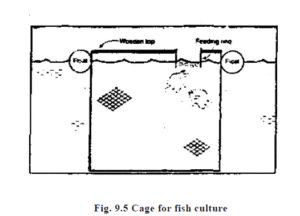
Small cages with mats of locally available plant materials such as palm leaves. Cyperus stem, Phragmites stem and split bamboo are used in India. These cages are of 1 – 2 m2 area. Split bamboos are joined with the help of coir rope or nylon twine. The cages are installed in the water body with bamboo supports at the four comers and the bottom. Materials other than bamboo mats are decayed by the third month and collapsed within a year. Split bamboo cages remain for over a year. Circular cages with thick bamboo stipes tied with nylon twine the durability of over 3 years.
Cages made up of monofilament woven material of 1 – 3 mm mesh size and 0.3 – 1 mm thickness are light and easy to handle, but remain for 6 to 12 months. The exposed part become brittle and gives way. Knotless nylon webbing of 3 – 6 mm mesh size and knotted nylon webbing of 7 -15 mm mesh have been found to be most durable. Cages made of water – proof surface painted light conduit pipe frames with a 10 m2 area are light in weight and have long durability. A battery of cages is enclosed with a bamboo catwalk and the whole structure floated by sealed empty barrels of 200 1. capacity.
The circular cages with conduit pipe structures which can be easily assembled have been designed with nylon webbing in different dimensions. These cages are floated freely on the water surface with the help of 3 – 4 sealed HDPP jerry cans. These arc extremely useful for cage culture. Due to their circular is shape the wave action in minimum. These can be moved from place to place with least water resistance. Due »their circular shape, the rearing space is maximum in side. The aeration and water circulation is better in these cages. Fishes can move in the cages with least obstruction.
Auto-floating, highly durable HDPP pipe frame nylon net cages with 36 m2 area are also used. These are light in weight and not need floats to float on the water surface.
The size of the cages depend on die scale of culture, species cultured, infrastruktur, financial and management resources. The size varies from 2- 10m3 in India, 100 – 150m3 in Indonesia, 60- 180m3 in Kampuchia. 40 – 625 m3 in Vietnam and 30 m3 in Holland. Large cages are operated in Germany with 42 m diameter and 16, 500 m3 at the water depth of 12 m. These are provided with automatic or water jet pump-feeding, special handling and harvesting accessories.
Cal t ura b l e fisk e s i n c age s ett d t h ei r sto c släkt g
The fishes used for the cage culture should be adaptable to captive culture, fast gro\vng, hardy and disease resistant. The Indian and Chinese carps, tilapia and magur can also be cultured where trash fish is cheaply and abundantly available. In Thailand and Kampuchia the cat fishes, Pangasius species are being cultured in cages successfully. Koi and Singhi are also cultured in India in cages.
I Indien, the nursery cages are stocked with carp fry at the range of 150-700 fry/in2 in caaes with different materials. In Japan 15.000-62.000 fry/nr2 of grass carp fry are stocked in nursery cages. The common carp stocking density is 150/nr2 in Kampuchia, 133 -417/nv1 in Indonesia and 80 – 360/nr2 in Vietnam. In Thailand Pangasius sutchi, P. larmmdi och P. micronemus fry are stocked at densities of 150-300/ nr2 in cages of size 1-10 m2 area with a depth of 1.5m. .
The number of fish that can be stocked in a cage is variable and depends on the canying capacity of the water area, water quality and rate of circulation, the fish species, the quality and quantity of feed supplied. A safe level may be about 3000 to 6000 fish/ ha. In able – fish rearing cages in India, the fingerlings of carps are stocked at density of 30 – 38no /m2 . The tilapia, Oreochromis mossambicus can be stocked a rate of 100 – 200 m-2. Murrels can be stocked at density of 40-100m2.
Ma n ag e män t ett d y i el d
The cage culture can be taken up in two phases – nursery phase and table – fish rearing phase. In nursery phase of cage culture, the spawn or fry are reared to fingerling stage in 2-3 months. Different feeds can be used for culture in nursery cages. Groundnut oil cake, ris kli, egg yolk, soyabean cake, soyamilk and soya flour are used as food for fry in nursery cages. The silkworm pupae are also tried as supplementary food.
The initial size of fish to be stocked in the cages will depend primarily on the length of the growing season and the desired size at harvest. The carp fingerlings for stocking in 16-20 mm mesh cages should be over 10 gr. to expect a final size of over 500 gr. within 6 months. It should be ensured that the fingerlings used for stocking are healthy and disease free. All the fish should be actively moving. It is ideal to stock cages in the cool part of the day.
I Indien, the growing season is almost year round, except for December – January in northern parts, where the temperature is low during these winter months. Very little natural food such as plankton, insects and various other organisms enter the cages and is available to fish. Dock, supplementary feeding is essential in the cage culture to get high production. The types of feed used will depend on the species cultured and their prevailing market prices. Murrels, till exempel, require to be fed with fish, shrimps or other animal matter. Most of the fish cultured are omnivorous and they accept both plant and animal byproducts such as oilcakes, brans, fish meal and silk worm pupae.
Cage fish are generally fed at least once daily throughout the growing period to get better growth. The quantity of feed to be given is important, since under-feeding will reduce growth and production, while over-feeding will waste costly feed and can affect the water quality. A method used to estimate the daily feed to be give in cages is based on the total weight of the fish. The feed is usually expressed on percentage of body weight. In carps, the feeding rate is 4 – 5 % of the body weight per day until they attain approximately 100 gr. And thereafter at 2 – 3 %.
In table-fish rearing phase, involving the high-tech system of saturated stocking and feeding on enriched formulated feeds, the production recorded in common carp is 25 – 35 Kg m° month’1 in foreign countries. The channel catfish, Lactarius punctatus in USA yielded a production of 20 – 35 Kg/nr3. In Africa, tilapia yielded 17 Kg/nr3and trout produced 15 Kg/nr3. The food quotient in these cultures varied from 1.3 – 2.1. I Indien, a production of 1.5 – 2.5 Kg nr:month’1 common carp was achieved with mixed feed of silk worm pupae, ground cake and rice bran. Catla yielded 1.4 – 2.7 Kg nr2 month’1 with groundnut cake and rice bran with the food quotient 5.6. Tilapia produced 1 – 1.6 Kg nr2 month’1 with a mixture of rice bran, groundnut cake and commercial cattle feed and food quotient ranged from 1.8- 2.3 . About 1 Kg nr2 month”’ of murrel and 0.3 – 1.5 Kg nr2 month’1 of catfishes, singhi and Koi are obtained.
Ca g e cu l tu re o f pr a wn s
The freshwater and marine prawns are also cultured in cages. The cages are stocked with wild or hatchery reared post larvae. Commercial scale rearing of post larvae in floating and fixed nursery cages (3.7 X 2.7 X 1.3 m) has been done with considerable success. They are fabricated from fine mesh (0.5 mm) nylon netting, supported by bamboo poles which are driven into the bottom of the water body. The optimal stocking density reported is 30, 000 post larvae/cage (2 .310 m’3). Feed is provided in trays fixed inside the cages. Initialt, the post larvae are fed on a paste of finely ground trash fish, later are fed with fresh mussel meat.
Pe n cultu r e
Recent results in the use of cages, pens or enclosures and recirculating water systems suggest some ways of compact intensification of production in aquaculture given the accessory inputs. This practice may provide great possibilities in the future in certain selected and suitable areas.
Aquaculture in open waters through the use of pens or enclosures is also a means of minimising the limiting effect of metabolities and pollutants on cultivated stock. Greater production in very limited space has been found possible under those situations. Production figures from these types of aquaculture environments approximates to 4 -10 t/ha/yr in Laguna lake in Philippines.
Se l ectio n o f s ite s fo r pe n cultu re
i) Low tidal amplitude
ii) Fish pen – site must be sheltered as much as possible against high winds
iii) Depth not less than 1 meter during lowest water level
iv) The best site is on the leeward side of the prevailing winds with moderate flow of current especially in a place where current in overturning
v) Water with stable PH slight variation is best. Avoid turbid and polluted water.
vi) Muddy clay and clay – loam soils are best types of bottom soil. Too much still and decomposing organic matter must be avoided.
C ons t ruc t io n o f sid sv s
Pens can be constructed with the help of bamboo screens and nets
a . Co n stru c tio n o f sid e n s w i t h b a mbo o scre e n s
Split bamboo should not necessarily be shaped and rounded. They are soaked in water for two weeks and then dried for one week. During the soaking and drying period, bamboo poles are prepared and staked at the chosen site according to thedesired size and shape of the fish pen. After stacking poles, bamboo splits are closely woven extending to a length of more or less five meters and made into a roll. After weaving, these are set by stretching them from one pole to the other interrurned or just set inside or outside close to the poles from bottom to top. They are tied every pole by rubber and one provided with sliced rubber around, liming one on top and one at the bottom. These splitted rubber prevent them from wear due to wave action. Nursery nets which should be 1/16 th to 1/10 th of the area of the fish pen can be set before constructing the fish pen or after it is set.
b C på s tr u cti o n o f sid e n wi t h n et s
Construction of a fish pen made out of synthetic netting is easier than one made of bamboo screens. Netting materials can be kuralon, nylon, cremona, tamsi. etc. An ordinary fisherman can connect the nets into the fish.pen after taking into account the desired height or depth of the pen site. After the net is constructed , the poles are staked in mud after making a provision for the front rope and tie rope at the interval of 1.0 – 2.0 m per stake and also the provision for float rope. In preparing the poles, all nodes are cleaned except one node with brunch protending one inch which is staked in the mud from 15 – 30 cm or more depending upon the depth of soft mud. With this node the foot rope is tied, and these together with the bottom net are staked in the mud. Boulders can be used as sinkers in the absence of lead sinkers. Bamboo tips of 1-1 Vi m are also used to stake the bottom net with a foot rope firm into the mud to avoid escape of the fish stock. Construction of the nursery net may be done before or after the construction of the fish pen. They should have a free board of about 1 meter above the normal water level to prevent entry or exit of fishes by jumping and as a precaution against water level fluctuations. Metal and metal coated with HDPP screens are often used for pens which is highly durable.
Cu l tu re
Pen culture is extensively practiced in Japan, Peru and Philippines. Fish formers in Laguna debay and Sansabo Kekes stock milk fish fingerlings in pens and grow them to marketable size (200 g or above). Prawn are also similarly cultured. Very little work has been done on pen culture of fishes in India.
Traditional trapping and extensive culture of tiger prawn, milk fish, pearl spot, mullet, bekti and thread fins are done in some sort of pens and enclosures in canals joining the backwaters in Kerala and in the shallow areas of Chilka lake (Janos) in Orissa. The pens are made by weaving split bamboo or with netting. The enclosing of fishes is done usually after the monsoon season upto late autumn and the culture period lasts for about 6 to 8 months. The size of Janos in the Chilka lake varies from 5 to 500 ha. Since the stocking and harvesting are not done systematically, precise production S3* figures areajatavailable. The yield, dock, is estimated to be about 60 Kg/ha/season.Seed rearing experiments were conducted in a split bamboo enclosure of 247.5 m2 reinforced with a nylon netting in Punarswamy Bhavanisagar (Tamilnadu). It was stocked with mrigal (size 7 mm) and Labeo fimbratus (size 5 mm) spawn at the rate of 4.6 million/ha and usual farm practices were followed. In 30 days mrigal attained a size of 38 mm and fimbriatus, 28 mm. At the time of conclusion of the study after 3 months, the former had attained a size of 88 mm and the later 75 mm. The overall survival obtained was 27.8 %.
Major carp seed rearing in pens is being done every year from 1982 onwards in the Tungabhadra reservoir in Karnataka. A shallow bay of the reservoir near Hampusagara is cordoned off with bamboo mats reinforced with Casuarina poles and lined with mononlament cloth during the summer months, prior to the reservoir getting filled. The pen is divided into several compartments with bamboo mats, lined with mononlament cloth. When the nursery pen, get water with the filling of reservoir, they are stocked with spawn of carps. The stocking density varies from 5 to 20 million spawn ha. The feed given is a mixture of ground nut cake and rice bran (1 :1). After 2 to 4 months the fingerlings
are enumerated and released in the reservoir. A överlevnad varying from 11 to 30 % is obtained from the varies nursery pens.
A pen culture experiment for raising cattle and rohu in Mamkamaun a flood plain lake in Gandak basic yields a computed production of 4/ ha/6 months. The experiment was conducted in a bamboo screen pen (1000m) and the stock was fed with a mixture of nee bran and mustard cake, apart from a feed formulated from the aquatic weeds collected from the lake. Since intrusion of fishes from outside including predators is possible in pens. It is important to stock larger fingerlings (over 50 g size) to ensure better survival. It is be desirable to have scale pen culture. The species mix and stocking rates will mainly depend on the natural food supply, supplemental feeding strategy, water depth and the duration of rearing.
Sup sid lem e nta r y f e edi n g
The fish pens that are densely stocked with 10-20 fish per square meter, generally need regular feeding at the rate of 4 -10 % of the total body weight of the stock at least once 3 week, or it could be divided into daily feeding. The amount of food to be given depends on the condition of the culture fish which could be checked through sampling at least once a month.
Managemen t
Management offish pens is more laborious and demanding than a fish farm, because there are more risks in managing fish pens. Fingerlings are liable to escape once a single bamboo split breaks or a small portion of the net is torn. Every now and then the fish pens have to be checked for any holes or breaks.
The fish pen site has to be laid idle at least one month a year so that excess food and other organic matter are completely decomposed before stocking with new fingerlings. If the site is not sheltered it would be advisable to remove the net or split bamboo screen during the stormy season and repeat during fine weather condition.
S um m ar y
The culturable species of air breathing fishes are Fig. 9.1
C h a nn a s t r a den u s – Big or striped murrel or snake head fish
C hann a punctatu s – Spotted murrel
Channa marulius – Giant murrel
Clarias batrachus – Magur
Heteropneustes fossilis – Singhi
Anabas testudineus – Koi or climbing perch.
Many species of trout are grown, but the three most common of them are the rainbow trout, Slamo gairdneri eller Oncorynchus mykiss, the Eurorean brown trout, S.trutta (Fig. 9.2)and the brook trout, Salvelinus fontinalis. Trouts have a streamlined body, narrow gill openings and reduced gills. Trouts are adapted to highly oxygenated waters and freezing point temperatures. Trouts have great power of locomotion with clinging and burrowing habits. Mouth is modified with rasping lips for food collection from pebbles, stenar, etc..
Sewage is a cloudy, dirty and odorous fluid from our toilets and kitchens of our houses. It has minerals and organic nutrients in a dissolved state or dispersed in a solid condition. Disposal of sewage has become a global problem because of urbanization. It is an effect of demophora, i.e. an unabated growth of human population. På senare år har sewage has become a major pollutant of inland waters, especially rivers. It is a source of many epidemics. It is responsible for a serious threat to soil and water ecosystems. The approach towards waste water disposal should be utilization of this residue with the concept of their reuse or recycle through an ecologically balanced system involving mainly aquaculture. The utility of sewage effluent to enhance fertility of freshwater ponds has long been known in many countries of the world.
In our country, especially in rural areas, mere has been a tremendous growth of biogas plants as a source of non-conventional energy. Biogas is also called as gober gas. The biogas plant is a device for conversion of fermentable organic matter, especially cattle dung into combustible gas and fully matured organic manure or slurry by anaerobic fermentation. The nutrients of the generated slurry can be harvested for production of feed and food and replace conventional inorganic fertilizers. Biogas slurry enhances fish production.










